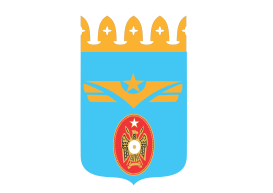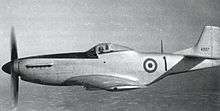Somali Air Force
| Somali Air Force | |
|---|---|
 Emblem of Somali Air force | |
| Founded | 1954 |
| Country |
|
| Branch | Somali Armed Forces |
| Type | Air force |
| Role | Aerial warfare |
| Part of | Somali Armed Forces |
| Garrison/HQ | Baledogle Airfield |
| Motto(s) |
Somali: Isku Tiirsada! English: Lean Together! |
| Colors | |
| Engagements |
1960-1964 Border Dispute Shifta War Ogaden War 1982 Ethiopian–Somali Border War |
| Commanders | |
| Current commander | Gen. Mohamoud Sheikh Ali Said |
| Notable commanders | Ali Matan Hashi 1960-1978 |
| Insignia | |
| Roundel |
 |
| Fin flash |
|
The Somali Air Force (SAF) (Somali: Ciidamada Cirka Soomaaliyeed) (CCS), (Arabic: القوات الجوية الصومالية), Al-Qūwāt al-Gawwīyä as-Ṣūmāl) is the air force of Somalia. The Somali Aeronautical Corps (SAC) was the name of the Somali Air Force during the pre-independence (1954–1960) period. After 1960, when Somalia gained independence, the name changed to the Somali Air Force. SAF principal organizer and the first Somalia pilot Ali Matan Hashi became the founder as well as the Chief of SAF.[1] The SAF at one point had the strongest airstrike capability in the Horn of Africa.[2] Following the outbreak of the civil war in the early 1990s, the air force disbanded. A reconstituted Somali Central Government later relaunched the SAF in the 2010s, with its headquarters being reopened in 2015.[3]
History
Following an agreement signed between the Somali and Italian governments in 1962, Somali airmen began a training regimen in Italy with the assistance of Italian technical staff and pilots.[4] Over the same period, fifty Somali cadets also commenced training in Soviet Union as jet aircraft pilots, later to be joined by more than two hundred of the nation’s elite NCOs and officers for general military training.[5] Most of these trained Somali military officials then returned to Somalia with the skills and knowledge that they had acquired abroad.

The Somali Air Force was established before Somalia's independence, and was at first equipped with a small number of Western aircraft, including Beech 18s and C-47 Dakotas for transport tasks, a few Piaggio P.148 trainers, P-51D Mustangs used as fighters, and a pair of Bell H-13 Sioux helicopters.
On 15 October 1969, while paying a visit to the northern town of Las Anod, Somalia's then President Abdirashid Ali Shermarke was shot dead by one of his own bodyguards. His assassination was quickly followed by a military coup d'état on October 21, 1969 (the day after his funeral), in which the Somali Army seized power without encountering armed opposition — essentially a bloodless takeover. The putsch was spearheaded by Major General Mohamed Siad Barre, who at the time commanded the army.[6] Barre then proclaimed Somalia to be a socialist state, and rapid modernization programs soon followed suit. Numerous Somali airmen were subsequently sent to train abroad in countries such as the United States, Italy, the Soviet Union, and the United Kingdom. After their training, many of these men went on to become the nation's leading instructors and fighter pilots. The Somali Air Force was at this time considered to be among the very best air forces on the continent.
Asli Hassan Abade was the first female pilot in the Somali Air Force. She had been training on single prop aircraft, and later earned a scholarship to study at the United States Air Force Academy.
Historical aircraft
On 30 July 1960, the following was the SAF's aircraft according to the administration of Air Defense in Mogadishu:[7]
Ogaden War (1977–1978)

In July 1977, the Ogaden War broke out after Barre's government sought to incorporate the predominantly Somali-inhabited Ogaden region in Ethiopia into a Pan-Somali Greater Somalia.[8] The Somali Armed Forces invaded the Ogaden and was successful at first, capturing most of the territory. The invasion reached an abrupt end with the Soviet Union's sudden shift of support to Ethiopia, followed by almost the entire communist world siding with the latter. The Soviets halted their previous supplies to Barre's regime and increased the distribution of aid, weapons, and training to Ethiopia's newly-communist Derg regime. They also brought in around 15,000 Cuban troops to assist the Ethiopian military. By 1978, the Somali troops were ultimately pushed out of the Ogaden.
The following was the Somali Air Force's major equipment in 1981:[9]
| Type | Description | Country of Manufacture | Inventory |
|---|---|---|---|
| Combat aircraft | |||
| MiG-17 Fresco | Mach 0.9 fighter-bomber | 40 | |
| MiG-21 Fishbed | Mach 2.1 fighter-bomber with AA-2 Atoll anti-aircraft missiles | 29 | |
| Il-28 Beagle | Subsonic jet light bomber | 3 | |
| Shenyang F-6 | Mach 1.3 fighter-bomber | 30 | |
| SF-260W | Single-engine light attack craft | 6 | |
| Hawker Hunter | fighter, reconnaissance aircraft | 8 | |
| Transport aircraft | |||
| An-2 | Single-engine light transport | 3 | |
| An-24/-26 | Twin-turboprop transport | ||
| C-47 | Twin-engine transport | ||
| C-45 | Twin-engine light transport | 1 | |
| G-222 | Twin-turboprop transport | 4 | |
| Helicopters | |||
| Mi-4 | Twelve-seat transport | 4 | |
| Mi-8 | Twin-engine medium transport | 8 | |
| AB-204 | General utility helicopter | 1 | |
| AB-212 | 4 | ||
| Trainers | |||
| MiG-15 UTI | Two-seat advanced jet trainer | 4 | |
| Yak-11 | Single-engine, two-seat advanced trainer | 20 | |
| P.148 | Single-engine, two-seat primary trainer | 6 | |
| SM-1019 | Single-engine training, observation, and light attack aircraft | ||
An Air Defence Command - seemingly a fourth service - was formed by the late 1980s. In 1987, according to U.S. DIA records, it was 3,500 strong, headquartered at Mogadishu, with seven AA gun/SAM brigades and one radar brigade. ()
Eight years later, the Somali Air Defence Force operated most of the surface-to-air missiles. As of 1 June 1989, the IISS also estimated that Somali surface-to-air defence equipment included 40 SA-2 Guideline missiles (operational status uncertain), 10 SA-3 Goa, and 20 SA-7 surface-to-air missiles.[10]

.jpg)
Disbandment
With the fall of Siad Barre's regime in 1991 and the start of the civil war, funding for any government activity, including the SAF, ended immediately. The remains of the SAF were subsequently photographed in a derelict state at Mogadishu Airport in 1993 by U.S. troops in Mogadishu.
Relaunch
In the early 2010s, the Somali Air Force was re-established by Somalia's central government. On October 29, 2012, 40 senior SAF and Somali National Army officers participated in the three-day Improving Understanding and Compliance with International Humanitarian Law (IHL) workshop in Djibouti. Organized by AMISOM as part of the Somali Armed Forces' National Security Stabilization Plan (NSSP), an initiative designed to strengthen and professionalize the national security forces, the program offered a refresher course on the essentials of IHL. Officials from Somalia's Ministry of Defence also took part, with the Djibouti Chief of Defence Forces opening the workshop.[11]
In October 2014, Somali Air Force cadets underwent additional training in Turkey.[12]
On 1 July 2015, the Somali Defence Minister Abdulkadir Sheikh Dini reopened the headquarter of the Somali Air Force. Located in Afisone, Mogadishu the move would facilitate the re-establishment of the air force after 25 years of civil war.[3]
The Somali National Air Force is not currently operational and has no aircraft. It is composed of approximately 170 personnel (40-50 officers ranging from second lieutenant to colonel and 120-130 Non-Commissioned Officers and Airmen). Turkey is delivering residential training to a group of young Somali air force personnel and intends to support the development of an aviation capability. The potential cumulative cost for an air arm development for the Somali Armed Forces would be over 10 years would be $50 million.[13]
Current inventory
The SAF´s inventory after its renewal is quite small, its main and only fixed wing aircraft being the G-222 transport plane and F-6 fighter plane. Most aircraft are in non flying conditions and many if not all the aircraft wear destroyed in 2011. All the Shenyang F-6's and G-222's are grounded and the status of the helicopters is uncertain
| Type | Description | Country of Manufacture | Inventory |
|---|---|---|---|
| Combat aircraft | |||
| Shenyang F-6 | Mach 1.3 fighter-bomber | 5 | |
| Transport aircraft | |||
| G-222 | Twin-turboprop transport | 4 | |
| Helicopters | |||
| AB-204 | General utility helicopter | 1 | |
| AB-212 | 4 | ||
| Trainers | |||
| P.148 | Single-engine, two-seat primary trainer | 6 | |
Ranks
- Officers
| Equivalent NATO code | OF-10 | OF-9 | OF-8 | OF-7 | OF-6 | OF-5 | OF-4 | OF-3 | OF-2 | OF-1 | OF(D) and student officer | |||||||||||||||||||||||||
|---|---|---|---|---|---|---|---|---|---|---|---|---|---|---|---|---|---|---|---|---|---|---|---|---|---|---|---|---|---|---|---|---|---|---|---|---|
(Edit) |
No equivalent |
 |
 |
 |
 |
 |
 |
 |
 |
No equivalent | ||||||||||||||||||||||||||
| Major General | Brigadier | Colonel | Lieutenant Colonel | Major | Captain | First Lieutenant | Second Lieutenant | |||||||||||||||||||||||||||||
- Enlisted
| Equivalent NATO Code | OR-9 | OR-8 | OR-7 | OR-6 | OR-5 | OR-4 | OR-3 | OR-2 | OR-1 | |||||||||||||||||||||||||||
|---|---|---|---|---|---|---|---|---|---|---|---|---|---|---|---|---|---|---|---|---|---|---|---|---|---|---|---|---|---|---|---|---|---|---|---|---|
(Edit) |
 |
 |
 |
 |
No equivalent | No insignia | ||||||||||||||||||||||||||||||
| Chief Warrant Officer | Warrant Officer Class 1 | Warrant Officer Class 2 | Warrant Officer Class 3 | Sergeant | Corporal | Lance Corporal | Aircraftman | |||||||||||||||||||||||||||||
See also
Notes
- ↑ Luigi Pestalozza, The Somalian Revolution, (Éditions Afrique Asie Amérique latine: 1974), p.27.
- ↑ The Soviet Union in the Horn of Africa: the diplomacy of intervention and Disengagement by Robert G Patman - p. 184
- 1 2 "Somalia Reopens Air Force Headquarter". Goobjoog News. 1 July 2015. Retrieved 3 July 2015.
- ↑ Italy. Centro di documentazione, Italy. Servizio delle informazioni, Italy; documents and notes, Volume 14, (Centro di documentazione: 1965), p.460.
- ↑ John Gordon Stewart Drysdale, The Somali dispute, (Pall Mall Press: 1964)
- ↑ Moshe Y. Sachs, Worldmark Encyclopedia of the Nations, Volume 2, (Worldmark Press: 1988), p.290.
- ↑ Historical Somali Aircraft Archived 2011-09-02 at the Wayback Machine.
- ↑ Tom Cooper, Wings over Ogaden: The Ethiopian–Somali War, 1978–1979 (Africa @ War Series) Helion and Company (April 19, 2015), ISBN 978-1909982383
- ↑ Somalia: A Country Study - Army Ranks and Insignia
- ↑ IISS Military Balance 1989–90, Brassey's for the IISS, 1989, 113.
- ↑ "AMISOM offers IHL training to senior officials of the Somali National Forces". AMISOM. Retrieved 23 November 2012.
- ↑ "Somali air force cadets in Turkey". Somalia Newsroom. 23 October 2013. Retrieved 9 May 2015.
- ↑ "Somalia Security and Justice Public Expenditure Review" (PDF). World Bank. 31 January 2017. Retrieved 20 May 2018.
References
- World Aircraft Information Files Brightstar publishing London File 338 sheet 4
- WorldAirForces.com, Historical Somali Aircraft
External links
- Air Combat Information Group, Somalia, 1980-1996
- Somali Hunters